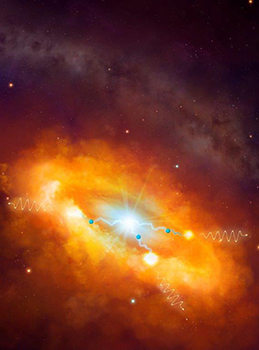Latest News Archive
Please select Category, Year, and then Month to display items
16 April 2024
|
Story Anthony Mthembu
|
Photo Supplied
 Melanie Ridgard celebrates receiving a Master of Business Administration (MBA) at the graduation ceremony held at the UFS Bloemfontein campus on 19 April 2024.
Melanie Ridgard celebrates receiving a Master of Business Administration (MBA) at the graduation ceremony held at the UFS Bloemfontein campus on 19 April 2024.
In the realm of self-development, few stories are as inspiring as that of Melanie Ridgard, the Interim Administration and Events Coordinator at the South African Research Chair in Industrial Development (SARChI-ID) at the University of Johannesburg (UJ). Ridgard’s forthcoming graduation with a Master in Business Administration (MBA) on 19 April 2024 from the University of the Free State (UFS) marks not only a personal triumph but also a testament to the transformative power of higher education.
Reflecting on her journey, Ridgard shares, “This moment signifies a culmination of rigorous studying, dedication and perseverance in mastering business fundamentals, leadership skills and strategic thinking.” Her pursuit of an MBA stemmed from a pivotal moment in her career when she was promoted at the Centre for Teaching and Learning (CTL) at UFS. Tasked with leading a group of young people Ridgard recognised the need to augment her knowledge to effectively guide her colleagues. The MBA became her vehicle for professional growth, extending beyond a mere qualification to a profound transformation of her leadership capabilities.
“Attaining an MBA milestone represents a transformative experience that has shaped my thinking to make impactful contributions in any future landscape,” Ridgard explains. Her experience not only enhanced her strategic acumen but also deepened her understanding of organisational dynamics. She acknowledges the pivotal role played by the UFS Business School in nurturing her journey towards academic and personal success.
What to expect from Ridgard
Looking ahead, Ridgard’s commitment to continuous learning remains unwavering. Selected as one of five MBA students to address the 17th International Business Conference (IBC) in September 2024, she eagerly anticipates the opportunity to share insights on her work titled, “Next-Gen Integration: Navigating the Onboarding Maze for Gen Z in Today's Workplace.” Despite her current responsibilities at UJ, she harbors plans to pursue a PhD in the near future.
Amidst her ambitious pursuits, Ridgard remains grounded, prioritising the celebration of her MBA achievement. ‘’As everyone dreams about it, I just want to walk over that stage in a black gown and a hood on my head with my loved ones cheering me on,’’ she shared.
Ridgard’s journey serves as a beacon of inspiration, exemplifying the transformative potential of education and the enduring impact of determined leadership. Her story reminds us that true leadership is not merely about reaching milestones but also about empowering others and embracing continuous growth.
Two scientists part of team that discovers the source of the highest energy cosmic rays at the centre of the Milky Way
2016-03-22

Artist's impression of the giant molecular clouds surrounding the Galactic Centre, bombarded by very high energy protons accelerated in the vicinity of the central black hole and subsequently shining in gamma rays.
Artist's impression: © Dr Mark A. Garlick/ H.E.S.S. Collaboration Spotlight photo:
Dr Brian van Soelen and Prof Pieter Meintjes of the UFS Department of Physics.
Photo: Charl Devenish
|
H.E.S.S. (High Energy Stereoscopic System) scientists publically revealed their latest galactic discovery in the international science journal, Nature, on 16 March 2016. These scientists were able to pinpoint the most powerful source of cosmic radiation – which, up to now, remained a mystery.
Part of this team of scientists are Prof Pieter Meintjes and Dr Brian van Soelen, both in the University of the Free State (UFS) Department of Physics. Dr Van Soelen explains that they have discovered a proton PeVatron – a source that can accelerate protons up to energies of ~1 PeV (10^15 eV) – at the centre of the Milky Way. The supermassive black hole called Sagittarius A has been identified as the most plausible source of this unprecedented acceleration of protons.
The protons are accelerated to Very High Energy (VHE) gamma rays. The energy of these protons are 100 times larger than those achieved by the Large Hadron Collider at CERN (the European Organization for Nuclear Research).
According to Dr Van Soelen, the fact that this research has been published in Nature demonstrates the importance and pioneering nature of the research conducted by H.E.S.S. The H.E.S.S. observatory – operational in Namibia – is a collaboration between 42 scientific institutions in 12 countries.
In 2006, H.E.S.S. was awarded the Descartes Prize of the European Commission – the highest recognition for collaborative research – and in 2010 the prestigious Rossi Prize of the American Astronomical Society. The extent of the observatory’s significance places it among the ranks of the Hubble Space Telescope and the telescopes of the European Southern Observatory in Chile.
“The next generation VHE gamma-ray telescope,” Dr Van Soelen says, “will be the Cherenkov Telescope Array (CTA), which is currently in the design and development stage.” Both Dr Van Soelen and Prof Meintjes are part of this project as well.
H.E.S.S. has issued a complete statement about the paper published in Nature.